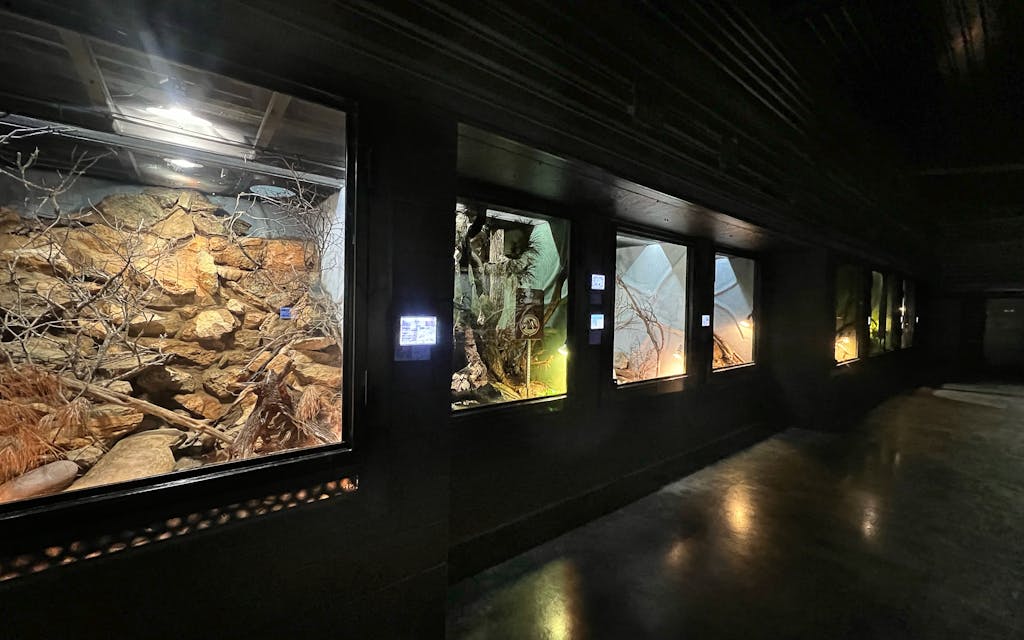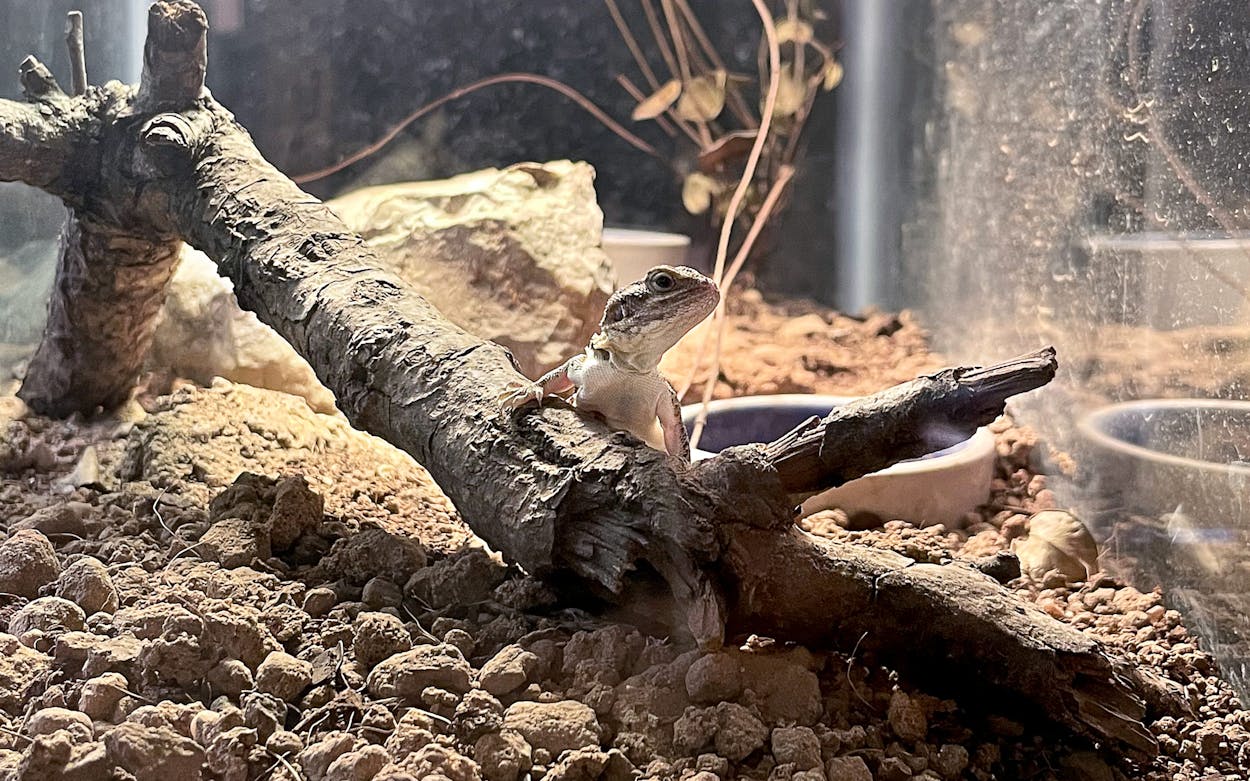On a Greek mountainside, the adders are courting. Two red-brown male snakes, their noses tipped with tiny horns, wave their heads at a female in sinuous attempts at seduction. Through the glass and across the hall, in a Florida mangrove forest, green anoles strut on branches over basking terrapins and the sleeping bulk of eastern diamondback rattlesnakes. Other massive exhibits fill the dark hallways of Reptilandia, a new reptile zoo just outside of Johnson City. Each enclosure is a portal to a different world: a Madagascan lowland jungle, an Arizona mountainside, a thicket on the Edwards plateau, all with their own cold-blooded cohorts.
The zoo, which opened in December 2022 and operates (for now) only on weekends, has a lot to live up to. The hills of Central Texas already host other reptile attractions, most famously New Braunfels’s Animal World & Snake Farm Zoo. The refrain with which Ray Wylie Hubbard immortalized the place in his catchy song “Snake Farm”—“just sounds nasty”—captures the general cultural suspicion around reptiles and the places that house them, often in shabby conditions. Reptilandia, which will fully open its doors by late May, aims to change that.
“I want people to walk in, and I want them to be first blown away by the beautiful design and how everything flows together,” said Ari Flagle, the zoo’s curator. “We have these gigantic, ambitious goals to create the most awe-inspiring reptile facility, with the goal for conservation and education.”
The project began under Quetzal Dwyer, an imposing but soft-spoken New Yorker. A man with a lifelong affinity for reptiles—and a self-taught scientist who’s written a number of papers on reptile breeding and distribution—Dwyer got his start at a reptile park in the Canary Islands before opening the first incarnation of Reptilandia in Costa Rica in 2004. That park has been open for almost two decades. By 2019, spurred partially by boredom and partially by Costa Rica’s tightening laws around reptile imports, Dwyer decided to open up a new venture in the Texas Hill Country. (His assessment of the area’s charms is succinct: “It’s got fair laws as far as working with reptiles. It’s got tourism. And I always liked Texas; the people are friendly.”)
In 2019, Dwyer approached Flagle, who’d spent the last thirteen years working at the Fort Worth Zoo, as well as leading a long-running independent fieldwork program studying New Guinea’s endangered Boelen’s python. Flagle had been present during the zoo’s conversion of its old reptile house into the inventive Museum of Living Art, a facility designed to showcase the beauty of the world’s reptiles and amphibians.

Flagle’s work in Fort Worth gave him a sense for how world-class reptile exhibits could be designed and constructed. Many traditional reptile collections, even in zoos, keep the animals in relatively cramped conditions, in part due to an older notion that cold-blooded creatures don’t need as much space as mammals. The resulting shadow boxes rarely do the animals any favors. “They get fat, they get depressed, they don’t breed,” Flagle said. Newer reptile houses have generally sought to combat this by including larger, more intricate enclosures, which offer their occupants a more realistic environment and room to roam. With Reptilandia, Dwyer and Flagle intended to push that idea even further. They envisioned massive, carefully designed enclosures, each simulating a specific habitat, complete with multiple coexisting species.
In 2019, Flagle and his family moved out to the “dirt property” Dwyer had scouted near Johnson City. Dwyer remained a legal resident of Costa Rica, flying up regularly to oversee construction; he officially moved onto the property in 2022. Some animals arrived as part of Dwyer and Flagle’s personal collections. Others came as private donations: an unusually colored rat snake, a western diamondback rattlesnake dropped off by a nearby farmer. Still more came from the team’s partnerships with Texas institutions like the Waco, Gladys Porter, and San Antonio zoos, as well as farther-flung facilities such as the Bronx Zoo. “We’re collaborating with other institutions for captive breeding and conservation work,” Flagle said.
The zoo’s first building is a house focusing on temperate species, with 21 large exhibits. (A second building, focusing on tropical species, is under construction.) The smallest of the tanks measures six by six feet, and the largest are more than twenty feet long, with tree trunks, branches, live plants, and large water pools teeming with fish. In the Mediterranean exhibit, an enormous legless lizard nosed around trundling Greek tortoises. In the Madagascan lowland rainforest, sausage-fat diving skinks and suspicious-looking plated lizards came and went from basking areas, peeling off to forage in the underbrush. Even the building’s several rattlesnake species—a family inclined toward stillness—seemed alert and engaged: in the mornings, Flagle said, he’s occasionally seen the enormous eastern diamondbacks in the Florida salt marsh going for leisurely swims, a behavior that the species rarely displays in zoos.
Encouraging such activity is part of the team’s goal. Rather than simply put exotic species in a box, Reptilandia tries to present all of their animals, including common ones, in spaces that show them to their best advantage. “A million places have map turtles on exhibit,” Flagle said, pointing to the underwater portion of a Georgia forest, where turtles grazed on the algae of submerged logs. “But do they have map turtles in an exhibit that measures, like, twenty feet long to promote natural behavior?”
It isn’t just the size of the exhibits that promotes naturalistic behavior but also their construction, Dwyer said. Specialized skylights let in UV rays that reptiles require. Live plants and invertebrates live in the dirt and leaf litter of the exhibits, helping decompose animal waste and controlling fungus; in the water, cleaner fish serve the same purpose. “A lot of reptiles live in a world of smell and touch,” Dwyer said. “If something smells and feels rich and woody, they’re gonna be a lot more comfortable.”
The large, naturalistic environments also encourage their occupants to feel comfortable enough to breed. “The ultimate goal is to walk down here in the morning with our coffee and see animals naturally behaving as they would and collect eggs and offspring,” Flagle said. Newborn lizards and snakes turn up regularly enough that Reptilandia has a little nursery display by the gift shop, small tanks filled with bright-eyed hatchlings.
The temperate house is just a proof of concept, however: the two-story tropical house is significantly larger and more ambitious. When I visited in early April, the building was still an active construction site, with unfinished landscaping and the sound of hammering ringing out from inside the main building. Inside, Dwyer showed off the bones of half-built exhibits, the largest of which stretched from water-filled tanks to two-story forests of fake trees. Themes included a trio of Pacific island tanks, the future home to geckos, skinks, and venomous sea kraits; a West African exhibit for rock pythons and mambas; a Southeast Asian jungle stream for finned Hydrosaurus lizards and monitors; and a fiberglass cavern for ghostly axolotl salamanders, blind cave fish, and Cuban cave anoles. A largely underwater exhibit for New Guinea’s Fly River turtles has a hidden land passage out and up to the second story in order to accommodate the turtles’ urge to climb away from water and lay their eggs; that passage itself opens into an exhibit for jungle lizards, which (hopefully) will occasionally be visited by nesting turtles.
The major goal here—aside from contributing to the captive breeding of increasingly threatened species—is education. Some of this is ethnographic rather than scientific. Flagle is also a reptile art collector, and the visitor building includes a one-room museum of reptile art and sculptures from Africa, Indonesia, and New Guinea, with more to be added as the space continues to grow. But the team wants to give people a chance to see reptiles in a new light by creating a space where they can behave as naturally as possible. “Our goal is to familiarize people with how interesting and how diverse reptiles are,” Dwyer said.
But Reptilandia is also aiming for something more aesthetically interesting than a laboratory setting, Flagle said. It’s difficult to grasp what an animal is outside of the context of its environment. The exhibits are thus designed for people to absorb themselves, full of hidden nooks and crannies and unexpected animals. “I want people to have to look,” he told me. When they do that, they’re more likely to study and appreciate the animals as a part of a natural setting, rather than simply glance and move on. Reptilandia’s tanks are designed to reward close attention and repeat visits. While visiting the temperate house, I found myself making multiple circuits, tracking the movements of animals in their enclosures as some species hid and others emerged.
“We get a lot of people that come in with a very stone face,” Flagle says. “Because they don’t know what to expect. They’re like, ‘Oh, reptiles, it’s going to be gross.’ And then I talk to them when they leave, and they’re all smiling.”
- More About:
- Critters
- Johnson City
- Hill Country






